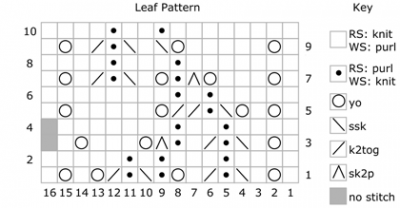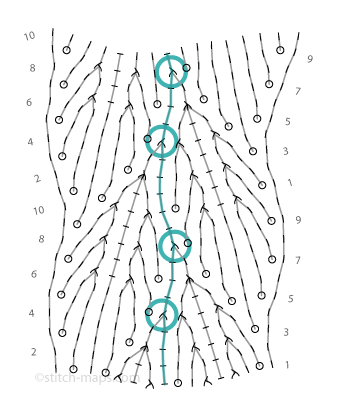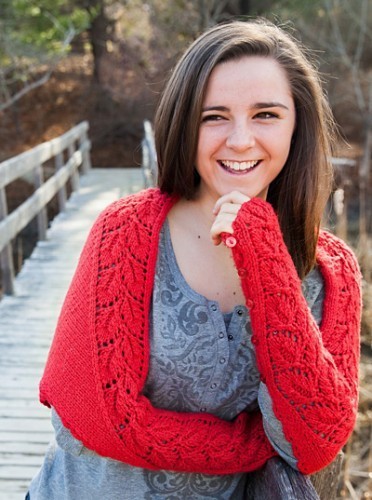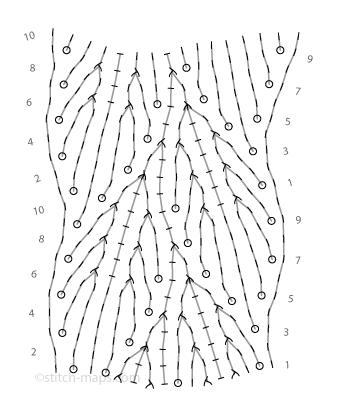Stitch Maps Charts and Hugga: Guest Post from JC Briar
Knitter, designer and author JC Briar developed the Stitch Maps charting tool, and in this blog post she shows the difference between a conventional lace chart and one of her “grid-less” stitch maps charts.
We thought you might enjoy seeing this alternate view of the stitch pattern, and JC’s illuminating analysis.
Being a chart geek, one of the things I enjoy most about perusing each new issue of Knitty is scoping out the charts: What stitch patterns do they depict? Are the charts straightforward, or do they have intriguing quirks? And, of course: are there charts that I’d rather see in the form of stitch maps?
In the Deep Fall issue, Hugga caught my eye.
Its double-leaf stitch pattern seemed symmetrical. But its chart?

The chart as published.
Not so much. The chart appeared jumbled to me: Where were the leaves? What was with the random sprinkling of purl symbols? And why did “no stitch” symbols sit along the chart’s left edge only, on rows 3 and 4? Looking at the symmetry in the Hugga photos, I would’ve expected matching “no stitch” symbols at the chart’s right edge, perhaps on rows 7 and 8.
A stitch map was definitely in order.
With two vertical repeats on display, and “column guides” highlighting the stitch columns, the leaves pop into view.
And the purl symbols resolve into focus: some line up along the center of each leaf; others form a vine running between the leaves.
Looking closely at the stitch map, I was able to figure out why “no stitch” symbols appear only on the left edge of the original chart. It’s because the stitch pattern isn’t actually symmetrical.
 The decreases that join the leaves to the vine aren’t evenly spaced. Sometimes they’re four rows apart; sometimes they’re six rows apart. As it turns out, this uneven spacing means row 3 has an extra decrease, and row 5 has an extra yarn over. So in the original chart, only rows 3 and 4 need “no stitch” symbols.
The decreases that join the leaves to the vine aren’t evenly spaced. Sometimes they’re four rows apart; sometimes they’re six rows apart. As it turns out, this uneven spacing means row 3 has an extra decrease, and row 5 has an extra yarn over. So in the original chart, only rows 3 and 4 need “no stitch” symbols.
Gleaning these bits of understanding from the stitch map was fun for me. I’m sure other chart geeks would find it fun too. But using a stitch map to understand a stitch pattern is decidedly useful too. Yeah, I could knit from the original chart – but I’m sure the knitting would flow a lot more easily now that I know how the leaves are formed, how the purls line up into veins and a vine, and where the leaves connect with the vine.
To learn more about JC’s tool, visit the website.

Mandy Moore's Blog
- Mandy Moore's profile
- 6 followers






